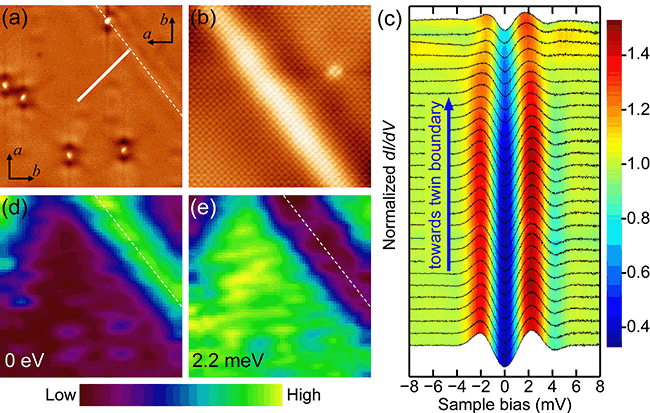Suppressing Superconductivity by Twin Boundaries in FeSe
Date:07-11-2012 Print
The response of superconductivity to crystal defects (e.g. twin boundaries, TBs) is crucial to two forefront technological issues, namely the sharpness of the superconducting transition and the critical current. Many early studies have revealed a slight enhancement in the superconducting critical temperature Tc near TBs of certain conventional superconductors. Meanwhile, TBs tend to pin vortices and so enhance the critical currents in the cuprate high-Tc superconductor YBa2Cu3O7-δ (YBCO). However, recent studies on Ba(Fe1-xCox)As2 show incompatible results whether the vortex is pinned on TBs or between TBs.
In the past two years, MA Xucun’s group in the Institute of Physics, Chinese Academy of Sciences, collaborated with XUE Qikun in Department of Physics, Tsinghua University, has carried out in-depth studies in the molecular beam epitaxial growth and superconductivity of β-FeSe thin films (Phys. Rev. B 84, 020503 (2011); Science 332, 1410 (2011)). Recently, in collaboration with Jennifer E. Hoffman in the Harvard University, they studied the superconductivity near TBs of FeSe superconducting film by using in situ low-temperature STM/STS.
First, by intentionally introduced excess Se atoms, dumbbelllike features appear (μ and ν in Fig. 1). Furthermore, these defects break the C4 symmetry at a much larger length scale (~ 4.4 nm) and form electronic dimer (yellow dashed line in Fig. 1(c)). The formation of TB can be confirmed through studying the orientation of electronic dimmers. Second, the superconducting gap decreases and superconducting coherence peak weakens when approaching the TB (Fig. 2 and 3). As compared to 2.2 meV on TB-free regions, the superconducting gap shrinks by 25% to 1.66 meV on TBs, which implies that TBs weaken the superconductivity of FeSe film within the coherence length scale. Third, magnetic vortices are preferentially pinned to the TBs (Fig. 4). These results reveal that TBs in FeSe films locally suppress superconductivity. By comparing the observation that TBs appear brighter than surrounding areas over a wide energy range with the structure and superconductivity of single crystal FeSe material under high pressure, the increased Se height (hSe) above the Fe layer around TBs could be attributed to the local suppression of superconductivity at TBs, which causes the distortion of FeSe4 tetrahedra structure and weakens the (π, π) spin fluctuation for pairing. This provides the first local evidence for the importance of the chalcogen or pnictogen height to the very nature of superconducting mechanism in iron-based materials.
The results were published on Physical Review Letters (PRL 109,137004 (2012)). The work was financially supported by National Basic Research Program of China, the National Natural Science Foundation of China Grants.
In the past two years, MA Xucun’s group in the Institute of Physics, Chinese Academy of Sciences, collaborated with XUE Qikun in Department of Physics, Tsinghua University, has carried out in-depth studies in the molecular beam epitaxial growth and superconductivity of β-FeSe thin films (Phys. Rev. B 84, 020503 (2011); Science 332, 1410 (2011)). Recently, in collaboration with Jennifer E. Hoffman in the Harvard University, they studied the superconductivity near TBs of FeSe superconducting film by using in situ low-temperature STM/STS.
First, by intentionally introduced excess Se atoms, dumbbelllike features appear (μ and ν in Fig. 1). Furthermore, these defects break the C4 symmetry at a much larger length scale (~ 4.4 nm) and form electronic dimer (yellow dashed line in Fig. 1(c)). The formation of TB can be confirmed through studying the orientation of electronic dimmers. Second, the superconducting gap decreases and superconducting coherence peak weakens when approaching the TB (Fig. 2 and 3). As compared to 2.2 meV on TB-free regions, the superconducting gap shrinks by 25% to 1.66 meV on TBs, which implies that TBs weaken the superconductivity of FeSe film within the coherence length scale. Third, magnetic vortices are preferentially pinned to the TBs (Fig. 4). These results reveal that TBs in FeSe films locally suppress superconductivity. By comparing the observation that TBs appear brighter than surrounding areas over a wide energy range with the structure and superconductivity of single crystal FeSe material under high pressure, the increased Se height (hSe) above the Fe layer around TBs could be attributed to the local suppression of superconductivity at TBs, which causes the distortion of FeSe4 tetrahedra structure and weakens the (π, π) spin fluctuation for pairing. This provides the first local evidence for the importance of the chalcogen or pnictogen height to the very nature of superconducting mechanism in iron-based materials.
The results were published on Physical Review Letters (PRL 109,137004 (2012)). The work was financially supported by National Basic Research Program of China, the National Natural Science Foundation of China Grants.
 |
| Figure 1. STM topography of (a-c) FeSe film with extra Se atoms appearing as bright atomic-scale dumbbells. Schematic crystal structures of (d) β-FeSe showing the inequivalent μ and ν Fe sites, and (e) illustrating a TB with Fe (blue) and Se (yellow) spheres.(Image by Ma Xucun et al) |
 |
| Figure 2. (a-b) STM topography with a TB indicated by a white dashed line. (c) Normalized dI/dV spectra taken at equal separations (1 nm) along the white solid line in (a). (d, e) Differential conductance maps recorded simultaneously with image (a) at energies of (d) zero and (e) 2.2 meV, respectively. (Image by Ma Xucun et al) |
 |
| Figure 3. Superconducting gap Δ (black diamonds) and ZBC (blue circles) plotted as a function of distance from the TB. The blue solid line depicts an exponential decay, while the black one is a guide to the eye. (Image by Ma Xucun et al) |
 |
| Figure 4. (a) A topographic image with three TBs. (b) Simultaneous ZBC map showing the vortices at 2 T. (c) Schematic illustrating both TBs (white dashes) and vortices (red circles). (Image by Ma Xucun et al) |


